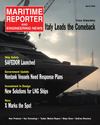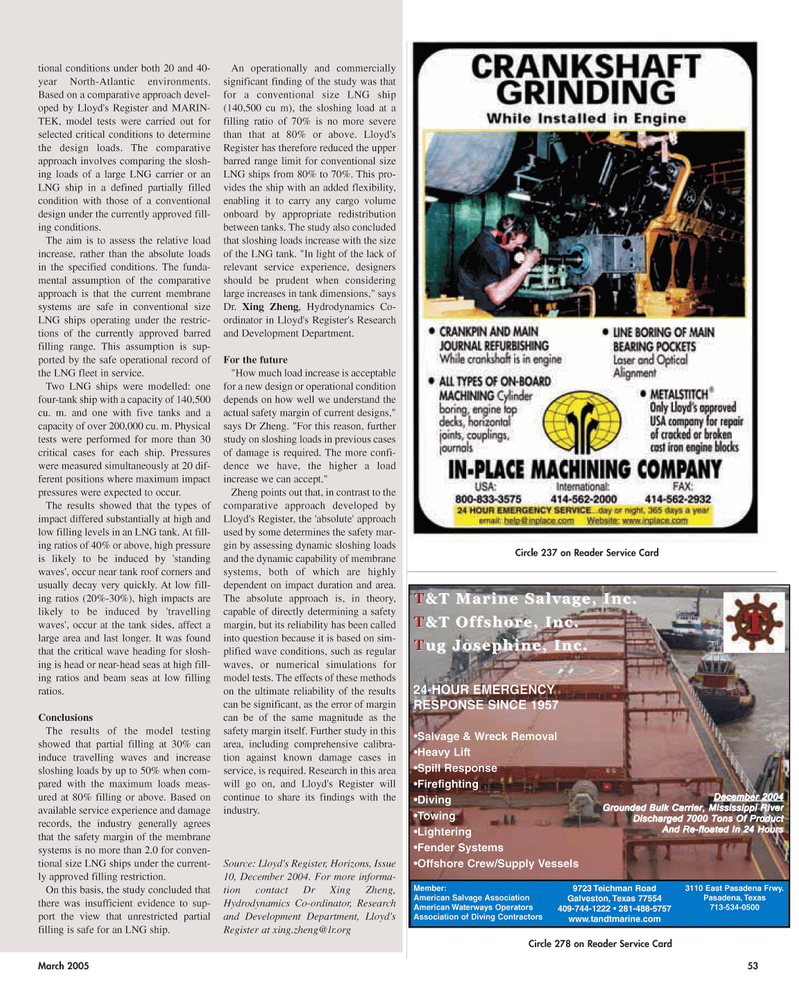
Page 53: of Maritime Reporter Magazine (March 2, 2005)
Read this page in Pdf, Flash or Html5 edition of March 2, 2005 Maritime Reporter Magazine
March 2005 53 tional conditions under both 20 and 40- year North-Atlantic environments.
Based on a comparative approach devel- oped by Lloyd's Register and MARIN-
TEK, model tests were carried out for selected critical conditions to determine the design loads. The comparative approach involves comparing the slosh- ing loads of a large LNG carrier or an
LNG ship in a defined partially filled condition with those of a conventional design under the currently approved fill- ing conditions.
The aim is to assess the relative load increase, rather than the absolute loads in the specified conditions. The funda- mental assumption of the comparative approach is that the current membrane systems are safe in conventional size
LNG ships operating under the restric- tions of the currently approved barred filling range. This assumption is sup- ported by the safe operational record of the LNG fleet in service.
Two LNG ships were modelled: one four-tank ship with a capacity of 140,500 cu. m. and one with five tanks and a capacity of over 200,000 cu. m. Physical tests were performed for more than 30 critical cases for each ship. Pressures were measured simultaneously at 20 dif- ferent positions where maximum impact pressures were expected to occur.
The results showed that the types of impact differed substantially at high and low filling levels in an LNG tank. At fill- ing ratios of 40% or above, high pressure is likely to be induced by 'standing waves', occur near tank roof corners and usually decay very quickly. At low fill- ing ratios (20%-30%), high impacts are likely to be induced by 'travelling waves', occur at the tank sides, affect a large area and last longer. It was found that the critical wave heading for slosh- ing is head or near-head seas at high fill- ing ratios and beam seas at low filling ratios.
Conclusions
The results of the model testing showed that partial filling at 30% can induce travelling waves and increase sloshing loads by up to 50% when com- pared with the maximum loads meas- ured at 80% filling or above. Based on available service experience and damage records, the industry generally agrees that the safety margin of the membrane systems is no more than 2.0 for conven- tional size LNG ships under the current- ly approved filling restriction.
On this basis, the study concluded that there was insufficient evidence to sup- port the view that unrestricted partial filling is safe for an LNG ship.
An operationally and commercially significant finding of the study was that for a conventional size LNG ship (140,500 cu m), the sloshing load at a filling ratio of 70% is no more severe than that at 80% or above. Lloyd's
Register has therefore reduced the upper barred range limit for conventional size
LNG ships from 80% to 70%. This pro- vides the ship with an added flexibility, enabling it to carry any cargo volume onboard by appropriate redistribution between tanks. The study also concluded that sloshing loads increase with the size of the LNG tank. "In light of the lack of relevant service experience, designers should be prudent when considering large increases in tank dimensions," says
Dr. Xing Zheng, Hydrodynamics Co- ordinator in Lloyd's Register's Research and Development Department.
For the future "How much load increase is acceptable for a new design or operational condition depends on how well we understand the actual safety margin of current designs," says Dr Zheng. "For this reason, further study on sloshing loads in previous cases of damage is required. The more confi- dence we have, the higher a load increase we can accept."
Zheng points out that, in contrast to the comparative approach developed by
Lloyd's Register, the 'absolute' approach used by some determines the safety mar- gin by assessing dynamic sloshing loads and the dynamic capability of membrane systems, both of which are highly dependent on impact duration and area.
The absolute approach is, in theory, capable of directly determining a safety margin, but its reliability has been called into question because it is based on sim- plified wave conditions, such as regular waves, or numerical simulations for model tests. The effects of these methods on the ultimate reliability of the results can be significant, as the error of margin can be of the same magnitude as the safety margin itself. Further study in this area, including comprehensive calibra- tion against known damage cases in service, is required. Research in this area will go on, and Lloyd's Register will continue to share its findings with the industry.
Source: Lloyd's Register, Horizons, Issue 10, December 2004. For more informa- tion contact Dr Xing Zheng,
Hydrodynamics Co-ordinator, Research and Development Department, Lloyd's
Register at [email protected]
Circle 237 on Reader Service Card
T&T Marine Salvage, Inc.
T&T Offshore, Inc.
Tug Josephine, Inc. •Salvage & Wreck Removal •Heavy Lift •Spill Response •Firefighting •Diving •Towing •Lightering •Fender Systems •Offshore Crew/Supply Vessels
December 2004
Grounded Bulk Carrier, Mississippi River
Discharged 7000 Tons Of Product
And Re-floated In 24 Hours
Member:
American Salvage Association
American Waterways Operators
Association of Diving Contractors 9723 Teichman Road
Galveston, Texas 77554 409-744-1222 • 281-488-5757 www.tandtmarine.com 3110 East Pasadena Frwy.
Pasadena, Texas 713-534-0500 24-HOUR EMERGENCY
RESPONSE SINCE 1957
Circle 278 on Reader Service Card
MR MARCH 2005 #7 (49-56).qxd 3/1/2005 4:55 PM Page 5

 52
52

 54
54
